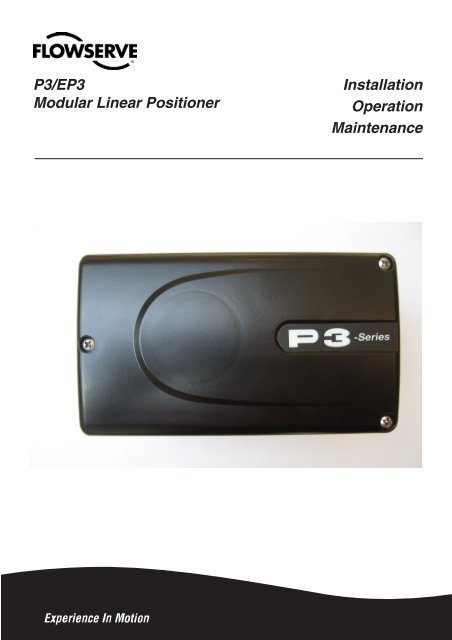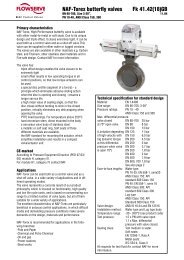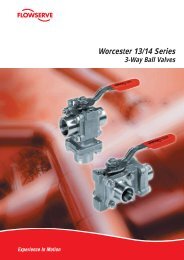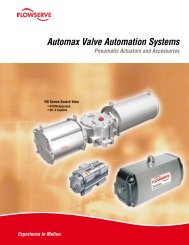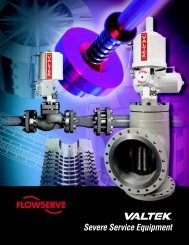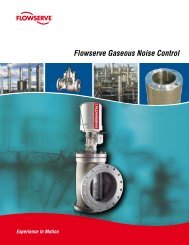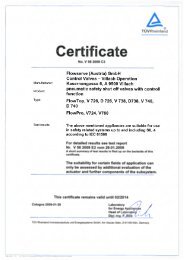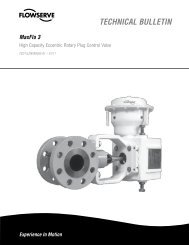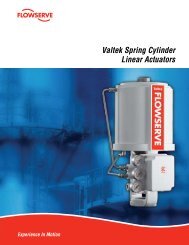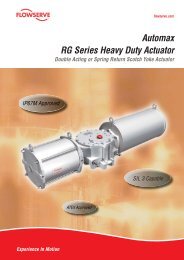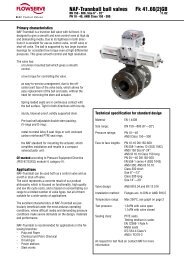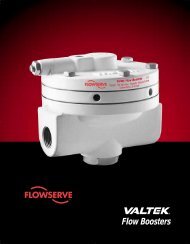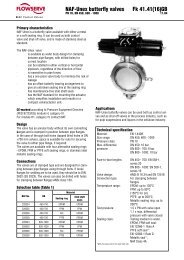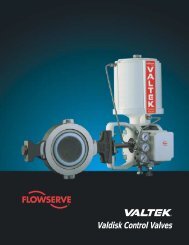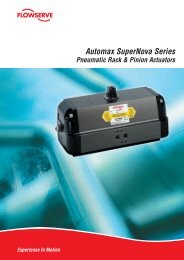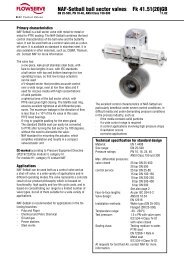Installation Operation Maintenance P3/EP3 Modular Linear Positioner
Installation Operation Maintenance P3/EP3 Modular Linear Positioner
Installation Operation Maintenance P3/EP3 Modular Linear Positioner
Create successful ePaper yourself
Turn your PDF publications into a flip-book with our unique Google optimized e-Paper software.
<strong>P3</strong>/E<strong>P3</strong><br />
<strong>Modular</strong> <strong>Linear</strong> <strong>Positioner</strong><br />
<strong>Installation</strong><br />
<strong>Operation</strong><br />
<strong>Maintenance</strong>
2<br />
Contents<br />
1. Introduction ................................................................................................................... 3<br />
Safety instruction ............................................................................................................... 3<br />
2. Storage ............................................................................................................................ 4<br />
General .............................................................................................................................. 4<br />
Storage indoors .................................................................................................................. 4<br />
Storage outdoors or for a longer period ............................................................................. 4<br />
Storage in a warm place .................................................................................................... 4<br />
3. Design.............................................................................................................................. 5<br />
4. Variants ........................................................................................................................... 6<br />
Standard designs ................................................................................................................ 6<br />
Optional equipment ........................................................................................................... 6<br />
5. Function .......................................................................................................................... 7<br />
General .............................................................................................................................. 7<br />
Increase in signal pressure ................................................................................................. 7<br />
Decrease in signal pressure ............................................................................................... 7<br />
6. <strong>Installation</strong>...................................................................................................................... 8<br />
Air supply requirements .................................................................................................... 8<br />
Mounting ........................................................................................................................... 9<br />
Connections ..................................................................................................................... 11<br />
Direct / Reverse function ................................................................................................. 11<br />
Single acting positioner ................................................................................................... 12<br />
Electrical connections ...................................................................................................... 13<br />
Control drawing ............................................................................................................... 14<br />
7. Adjustments.................................................................................................................. 15<br />
Gain ................................................................................................................................. 15<br />
Default settings ................................................................................................................ 15<br />
Setting the zero position and span ................................................................................... 15<br />
8. <strong>Maintenance</strong>/service .................................................................................................... 16<br />
Valve block ...................................................................................................................... 16<br />
Flapper nozzle ................................................................................................................. 17<br />
Gain screw ....................................................................................................................... 17<br />
Integral I/P converter ....................................................................................................... 17<br />
Feedback arm / Spindle ................................................................................................... 18<br />
9. Trouble shooting .......................................................................................................... 19<br />
10. Technical data ............................................................................................................ 20<br />
11. Spare Parts List .......................................................................................................... 22
1. Introduction<br />
The PMV <strong>P3</strong> is a modular <strong>Positioner</strong> system<br />
designed for use on control valves with<br />
linear motion. The basic unit is the <strong>P3</strong> positioner,<br />
which is available for single acting.<br />
The I/P converter can be integral, located in<br />
a separate mounted module (Ex), or located<br />
elsewhere. The <strong>P3</strong> can be equipped with<br />
connection blocks for pressure gauges to<br />
indicate:<br />
- actuator pressure<br />
- air supply pressure<br />
- input signal pressure<br />
3<br />
Safety instruction<br />
Read the safety instructions in this<br />
manual carefully before using the product.<br />
The installation, operation, and<br />
maintenance of the product must be done<br />
by staff with the necessary training and<br />
experience.<br />
PMV <strong>P3</strong> basic unit<br />
PMV <strong>P3</strong> with<br />
explosion proof I/P
4<br />
2. Storage<br />
General<br />
The PMV positioner is a precision instrument.<br />
Therefore it is essential that it is<br />
handled and stored in the correct way.<br />
Always follow the instructions below!<br />
N.B. As soon as the positioner is<br />
connected and started, an internal air bleed<br />
will provide protection against corrosion<br />
and prevent the ingress of moisture. For this<br />
reason, the air supply should always be kept<br />
on.<br />
Storage indoors<br />
Store the positioner in its original<br />
packaging. The storage environment must<br />
be clean, dry and cool, (15 to 26°C,<br />
59 to 79°F).<br />
Storage outdoors or for a<br />
longer period<br />
If the positioner must be stored<br />
outdoors, it is important that all the cover<br />
screws are tightened and that all connections<br />
are properly sealed. The unit should be<br />
packed with a desiccant in a plastic bag or<br />
similar, covered with plastic, and not exposed<br />
to sunlight, rain, or snow.<br />
This is also applicable for long-term<br />
storage (more than 1 month) and for long<br />
transport by sea.<br />
Storage in a warm place<br />
When a positioner is stored in a warm<br />
place with a high relative humidity and is<br />
subjected to daily temperature variations, the<br />
air inside the unit will expand and contract.<br />
This means that air from outside the unit<br />
may be drawn into the positioner. Depending<br />
on the temperature variations, relative<br />
humidity, and other factors, condensation and<br />
corrosion can occur inside the unit, which in<br />
turn can give rise to functional disorders or<br />
a failure.
3. Design<br />
The <strong>P3</strong> positioner comprises a basic<br />
module with a single acting valve block. It<br />
also includes a sealed chamber with terminals<br />
for the electrical input signals.<br />
The I/P unit can be built into the main<br />
housing (as shown in the figure below) or<br />
I/P<br />
converter<br />
Electrical<br />
connection<br />
Feedback arm<br />
Zero position<br />
adjustment<br />
Feedback spring<br />
located externally (explosion proof), see<br />
section ”Variants”.<br />
The adjusting screws and knobs are<br />
accessible under the removable sealed aluminium<br />
cover.<br />
Balance arm<br />
Adjusting screw,<br />
damping<br />
Flapper nozzle<br />
Span<br />
adjustment<br />
Figure shows <strong>P3</strong> positioner with integral I/P converter and cover removed<br />
➠ C+<br />
➠<br />
Supply<br />
Input<br />
3-15 psi<br />
5<br />
Adjusting<br />
screw, gain
6<br />
4. Variants<br />
Standard designs<br />
<strong>P3</strong>/E<strong>P3</strong> is available single acting.<br />
I/P converter can be integral or located<br />
elsewhere.<br />
<strong>P3</strong><br />
Pneumatic, single acting, to be<br />
connected to an external I/P converter.<br />
E<strong>P3</strong>, E<strong>P3</strong>IS<br />
Electro-pneumatic, single , with integral<br />
I/P converter. Intrinsically safe model also<br />
available.<br />
E<strong>P3</strong>EX<br />
Explosion proof model, I/P converter<br />
located in separate, sealed enclosure.<br />
Optional equipment<br />
<strong>P3</strong> / E<strong>P3</strong> positioner can be equipped<br />
with connection blocks and pressure gauges<br />
for:<br />
- input signal pressure<br />
- input air supply pressure<br />
- output pressure<br />
<strong>P3</strong>/E<strong>P3</strong><br />
E<strong>P3</strong> EX
5. Function<br />
General<br />
The <strong>P3</strong> positioner operates on the force balance principle. Changes are initiated by the<br />
signal pressure from the I/P converter. The functionality is described briefly below.<br />
Single action<br />
Signal<br />
pressure<br />
Feedback arm<br />
Relay<br />
diaphragm<br />
Signal diaphragm Balance arm Flapper nozzle<br />
Increase in signal pressure<br />
When the air pressure on the signal<br />
diaphragm increases, the balance arm is pressed<br />
down and the flapper nozzle closes. The<br />
pressure on the relay diaphragm then<br />
increases and the plug valve opens.<br />
Air is now supplied to the actuator, the<br />
spindle movement rotates the feedback arm,<br />
the balance arm is lifted, and the flapper<br />
nozzle opens. The pressure on the relay<br />
diaphragm is reduced and the plug valve<br />
reduces the air flow to the actuator. An<br />
equilibrium position is thus reached and the<br />
valve being controlled is in the desired position.<br />
Plug<br />
valve<br />
Venting<br />
Air<br />
supply<br />
7<br />
To/from<br />
actuator<br />
Decrease in signal pressure<br />
When the air pressure on the signal<br />
diaphragm is reduced, the balance arm is<br />
lifted and the flapper nozzle opens. The<br />
pressure on the relay diaphragm is then<br />
reduced and the plug valve upper seal opens<br />
and vents.<br />
Air is now ventilated from the actuator<br />
and its spindle moves. The actuator<br />
movement goes back through the arm<br />
mechanism (see figure) to the positioner<br />
spindle, which rotates the feedback arm. The<br />
balance arm is now lowered by the reduced<br />
spring force and closes the flapper valve. An<br />
equilibrium position is thus reached and the<br />
valve being controlled is in the desired position.
8<br />
6. <strong>Installation</strong><br />
Air supply requirements<br />
Max. air supply pressure, see the section<br />
Technical Data on page 20.<br />
The supply air must be free from<br />
moisture, water, oil, and particles.<br />
The supply air must be dried or be treated<br />
in such a way that its dew point is at least<br />
10°C (18°F) below the lowest expected<br />
ambient temperature.<br />
Before the air supply is connected to the<br />
positioner, we recommend the hose is opened<br />
freely for 2 to 3 minutes to allow any contamination<br />
to be blown out. Direct the air jet<br />
into a large paper bag to trap any water, oil,<br />
or other foreign materials. If this indicates<br />
that the air system is contaminated, it should<br />
be properly cleaned.<br />
To ensure a stable and problem-free operation,<br />
we recommend the installation of a<br />
filter/pressure regulator
Mounting according to IEC 534-6<br />
N.B. If the positioner is installed in a<br />
hazardous environment, it must be of a<br />
type approved for this purpose.<br />
The positioner has an ISO F05 footprint<br />
(A). The holes are used to attach it to the<br />
mounting bracket (B), which is suitable for<br />
most types of linear actuators.<br />
The arm (C) is graduated in mm and<br />
A B<br />
C D<br />
9<br />
inches. The scale is used to adjust the pin<br />
(D) so its position corresponds to the stroke<br />
of the valve stem.<br />
It is important that the positioner’s<br />
spindle and the arms, that transfer the<br />
actuator movements, are correctly mounted.<br />
Any tension between these parts can cause<br />
incorrect operation and abnormal wear.
10<br />
Mounting instructions for <strong>P3</strong>/E<strong>P3</strong> with mounting kit 30168S
Connections<br />
Air:<br />
Port S Supply air<br />
Port C+ Connection to actuator<br />
Port IP Pneumatic input signal<br />
(external I/P)<br />
Electrical connection<br />
Port I E<br />
Dimensions<br />
Electric input signal<br />
Air connections: 1/4" NPT alt. G 1/4"<br />
Electrical connection: M20 x 1.5 alt.<br />
NPT 1/2"<br />
Loctite 577 or equivalent is<br />
recommended as a sealant.<br />
Direct / Reverse function<br />
It is simple to adapt the positioner for<br />
direct or reverse function. Unscrew the<br />
flapper valve nozzle and reverse it, and<br />
change the mounting on the actuator. See<br />
figure page 12.<br />
4-20 mA<br />
Data for air and electrical<br />
connections, see section<br />
Technical Data on page 20.<br />
Flapper valve position<br />
11<br />
➠ C+<br />
➠<br />
Supply<br />
Input<br />
3-15 psi
12<br />
Single action positioner<br />
Actuator with closing spring, flapper<br />
nozzle set for reverse function<br />
When the signal from the I/P unit<br />
increases, the pressure C+ to the actuator is<br />
increased. The valve stem moves upwards.<br />
Actuator with closing spring, flapper<br />
nozzle set for direct function<br />
When the signal from the I/P unit<br />
increases, the pressure C+ to the actuator is<br />
reduced. The spring forces move the valve<br />
stem downwards.<br />
Actuator with opening spring, flapper<br />
nozzle set for reverse function<br />
When the signal from the I/P unit<br />
increases, the pressure C+ to the actuator is<br />
increased. The valve stem moves<br />
downwards.<br />
Actuator with opening spring, flapper<br />
nozzle set for direct function<br />
When the signal from the I/P unit<br />
increases, the pressure C+ to the actuator is<br />
reduced. The spring forces move the valve<br />
stem upwards.<br />
S<br />
C+<br />
S<br />
C+<br />
S<br />
C+<br />
S<br />
C+
Electrical connections<br />
On positioners with an integral I/P unit,<br />
the electric cables are connected to the<br />
terminals as shown in the figure.<br />
Model code<br />
Signs<br />
Warning! In a hazardous<br />
environment where there is a<br />
risk of explosion, electrical<br />
connections must comply<br />
with the relevant regulations.<br />
Terminals in<br />
positioner E<strong>P3</strong><br />
+<br />
–<br />
Hazardous areas<br />
A= Model no<br />
P P 3 X X <strong>Linear</strong> positioner, Pneumatic<br />
E P 3 X X <strong>Linear</strong> positioner, Electropneumatic<br />
E P 3 I S <strong>Linear</strong> positioner, Electropneumatic, Intrin.Safe ATEX, IEC<br />
E P 3 E X <strong>Linear</strong> positioner, Electropneumatic, Explosion proof ATEX, IEC, FM<br />
B= Function<br />
S Single acting<br />
C= Connections Air - Electrical<br />
M 1/4" NPT - M20x1,5<br />
N 1/4" NPT - 1/2" NPT<br />
D= Surface treatment<br />
U Powder epoxy, black<br />
E= Spindle<br />
0 5 Male dia. 10 mm<br />
3 9 Male D type incl nut<br />
F= Cover<br />
P V PMV cover, black, no indicator<br />
G= Input signal<br />
3 3-15 psi<br />
4 4-20 mA<br />
H= Temperature<br />
Z -40 to + 85 deg C<br />
I= Option<br />
X No gauge block<br />
M Gauge manifold 1/8" G<br />
N Gauge manifold 1/8" NPT<br />
P 3 - U - P V - Z<br />
13<br />
Output signal<br />
from controller<br />
+<br />
–<br />
Please see www.pmv.nu/products/ for<br />
copies of certificates for hazardous<br />
approvals.<br />
Logotype<br />
Type<br />
II 2G Ex ia IIC T6/T5/T4<br />
NEMKO 08ATEX1144X<br />
Intrinsically safe when installed<br />
according to document: IP-653<br />
Type: E5-IS<br />
Input Signal:<br />
Input Pressure:<br />
Output Pressure:<br />
Temp. Range:<br />
Action:<br />
Flowserve Sweden, Palmstierna International Solna Sweden<br />
www.flowserve.com<br />
36<br />
0470<br />
P<strong>P3</strong> E<strong>P3</strong><br />
Prod. year:xxxx<br />
25
14<br />
Control drawing
7. Adjustments<br />
Gain<br />
Default settings<br />
The positioner is supplied from the<br />
factory with default settings.<br />
If the settings have been changed, the<br />
default settings can be reset as follows:<br />
• Apply an input signal equivalent to maximum<br />
stroke (100%).<br />
• Screw in (clockwise) the setting screw A<br />
for gain to its bottom position.<br />
• Unscrew (counter clockwise) the same<br />
screw until the actuator is at max. stroke and<br />
then a further 1/4 of a turn.<br />
• Press on the flapper nozzle lightly (see<br />
arrow) to ensure that it is sealing properly.<br />
• Adjust the input signal to approx. 50%. If<br />
resonance occurs, turn the setting screw A<br />
counter clockwise a little more. The<br />
adjusting screw for damping B can also be<br />
screwed in a little if necessary. However,<br />
this will slow down the actuator movements.<br />
Setting the zero position and span<br />
If the zero position and span have been<br />
changed, adjust them as follows:<br />
• Apply an input signal equivalent to the zero<br />
position.<br />
• Turn the setting screw C for zero position<br />
until the actuator is at its zero position.<br />
• Apply the maximum input signal.<br />
• Turn the adjusting screw D for range until<br />
the actuator moves to max. stroke<br />
• Adjust the input signal again to minimum<br />
and check the zero position.<br />
C<br />
B<br />
➞<br />
15<br />
A<br />
D
16<br />
8. <strong>Maintenance</strong>/service<br />
When service or rebuilding is required,<br />
it may be necessary to remove and refit<br />
various parts of the positioner. This is<br />
described on the following pages.<br />
Valve block<br />
The valve block is mounted on the base<br />
with three screws. It is sealed against the air<br />
ducts in the base with O-rings.<br />
Remove the valve block as follows:<br />
• Remove the spring from its attachment hole<br />
A in the balance arm.<br />
• Unscrew the screws holding the block assy.<br />
• Lift the lower edge of the valve block and<br />
pull it away from the base in the direction of<br />
the arrow in the figure.<br />
• Check all the O-rings on the rear side of<br />
the valve block and replace if necessary.<br />
• Refit in the reverse order.<br />
Cleanliness is essential when working<br />
with the positioner. Contamination in<br />
the air ducts will lead to operational<br />
disturbances. Do not disassemble the<br />
unit further than that described here.<br />
Do not take the valve block apart<br />
because its function will be impaired.<br />
Do not remove any screws other than<br />
those described here.<br />
A
Flapper nozzle<br />
The flapper valve holder can be mounted<br />
in two different ways, depending on the<br />
required function. This is described on page<br />
11. Change the function or replace the Orings<br />
as follows:<br />
• Unscrew the screws C and D and remove<br />
the holder E. Check both the O-rings and<br />
replace them if necessary.<br />
• Replace the holder in the desired position<br />
and tighten the screws.<br />
Gain screw<br />
The sleeve F can be unscrewed to replace<br />
the O-ring G. Let the adjusting screw remain<br />
in the sleeve.<br />
Integral I/P converter<br />
The I/P converter can be removed if it is<br />
necessary to replace it, to replace the O-rings,<br />
or to rebuild the positioner.<br />
• First unscrew the two screws H that hold<br />
the terminal block. Release part of the rubber<br />
seal so that the cables to the terminal block<br />
can be pulled free from the grommet and the<br />
terminal block can be pulled through.<br />
• Remove the I/P unit with its cable and terminal<br />
block.<br />
• Replace the O-rings if necessary and refit<br />
the I/P unit or the rebuilding parts.<br />
H<br />
F<br />
G<br />
C<br />
E<br />
D<br />
17
18<br />
Feedback arm / Spindle<br />
The feedback arm is mounted on the<br />
spindle with a friction clutch comprising<br />
several disc springs. Remove the feedback<br />
arm/spindle as follows:<br />
• Remove the circlip J, the washer K behind<br />
it, and the O-ring L.<br />
• Release the spring from its upper<br />
attachment M.<br />
• Pull out the spindle with the feedback arm.<br />
Remove the feedback arm as follows:<br />
• Clamp the spindle in such a way that its<br />
surfaces cannot be damaged.<br />
• Undo the bolt N and remove the feedback<br />
arm and the seven disc springs O.<br />
• Refit in the reverse order. The disc springs<br />
O must be fitted in the way shown in the<br />
figure below. Lubricate the O-ring L with<br />
silicone grease.<br />
• Check whether there is any play on the<br />
spindle. If so, replace the teflon bushes P.<br />
J K L O<br />
P N<br />
J, K, L<br />
M
9. Trouble shooting<br />
Fault symptom<br />
Change in input signal to positioner does<br />
not affect actuator position.<br />
Change in input signal to positioner makes<br />
actuator move to its end position.<br />
Inaccurate positioning.<br />
Action<br />
• Check air supply pressure and connection<br />
between positioner and actuator.<br />
• Check input signal to positioner.<br />
• Check output signal from I/P converter.<br />
• Check mounting and connections of positioner<br />
and actuator.<br />
• Check function of diaphragm block.<br />
• Check input signal.<br />
• Check mounting and connections of positioner<br />
and actuator.<br />
• Uneven air supply pressure.<br />
•Uneven input signal.<br />
• Wrong size of actuator being used.<br />
• High friction in actuator/valve package.<br />
• Excess play in actuator/valve package.<br />
• Excess play in mounting of positioner<br />
on actuator.<br />
• Defect or leaking diaphragm block.<br />
19
20<br />
10. Technical data<br />
Common data<br />
Repeatability
22<br />
11. Spare Parts List<br />
1<br />
4 3 2
Pos. Part no. Description<br />
1 E5-STD I/P Converter general purpose<br />
1 E5-IS I/P Converter intrinsically safe<br />
2 E3-EX I/P Converter explosion proof, incl bracket<br />
3 <strong>P3</strong>-SP15 Air relay module, single acting<br />
4 7-SP25B Cover incl screws<br />
23
Germany<br />
Flowserve<br />
Sperberweg 16<br />
D-41468 Neuss<br />
GERMANY<br />
Tel: +49 (0) 2131 795 74 80<br />
Fax: +49 (0) 2131 795 74 99<br />
E-mail: pmvgermany@flowserve.com<br />
UK<br />
Flowserve<br />
Abex Road<br />
Newbury, Berkshire, RG14 5EY<br />
UK<br />
Tel: +44 (0) 1635 46 999<br />
Fax: +44 (0) 1635 36 034<br />
E-mail: pmvukinfo@flowserve.com<br />
Scandinavia<br />
Palmstiernas Svenska AB<br />
Box 21<br />
663 21 Skoghall<br />
Sweden<br />
Tel: +46 (0)54 52 14 70<br />
Fax: +46 (0)54 52 14 42<br />
e-mail: info@palmstiernas.se<br />
Palmstierna International AB<br />
Korta Gatan 9<br />
SE-171 54 Solna<br />
SWEDEN<br />
Tel: +46 (0) 8 555 106 00<br />
Fax: +46 (0) 8 555 106 01<br />
E-mail: infopmv@flowserve.com<br />
www.pmv.nu<br />
Italy<br />
Flowserve Spa<br />
Via Prealpi, 30<br />
20032 Cormano (Milano)<br />
ITALY<br />
Tel: +39 (0) 2 663 251<br />
Fax: +39 (0) 2 615 18 63<br />
E-mail: infoitaly@flowserve.com<br />
USA, Mexico<br />
PMV-USA<br />
1440 Lake Front Circle, Unit 160<br />
The Woodlands, TX 77380<br />
USA<br />
Tel: +1 281 292 7500<br />
Fax: +1 281 292 7760<br />
E-mail: pmvusa@flowserve.com<br />
Canada<br />
Cancoppas Limited<br />
2595 Dunwin Drive, Unit 2<br />
Mississuga, Ont L5L 3N9<br />
CANADA<br />
Tel: +1 905 569 6246<br />
Fax: +1 905 569 6244<br />
E-mail: controls@cancoppas.com<br />
Asia Pacific Headquarters<br />
Flowserve Pte Ltd.<br />
No. 12 Tuas Avenue 20<br />
REPUBLIC OF SINGAPORE 638824<br />
Tel: +65 (0) 687 98900<br />
Fax: +65 (0) 686 24940<br />
E-mail: fcdasiaprocess@flowserve.com<br />
South Africa<br />
Flowserve<br />
Unit 1, 12 Director Road<br />
Spartan Ext. 2<br />
1613 Kempton Park, Gauteng<br />
SOUTH AFRICA<br />
Tel: +27 (0) 11 397 3150<br />
Fax: +27 (0) 11 397 5300<br />
The Netherlands<br />
Flowserve Flow Control Benelux<br />
B.V<br />
Postbus 1501<br />
4700 Roosendaal<br />
THE NETHERLANDS<br />
Tel: + 31 (0)165 598898<br />
Fax: + 31 (0)165 555670<br />
China<br />
Flowserve<br />
Hanwei Building<br />
No. 7 Guanghua Road<br />
Chao Yang District<br />
100004 Beijing<br />
CHINA<br />
Tel: +86 (10) 6561 1900<br />
Fax: +86 (10) 6561 1899<br />
FCD PMENIM0012-02


